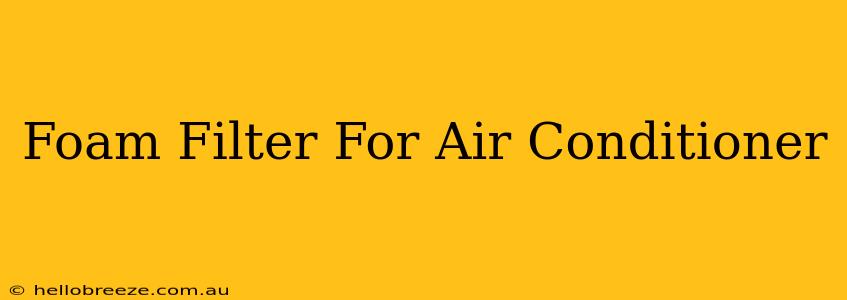Maintaining a clean and efficient air conditioning system is crucial for both comfort and health. A key component in this maintenance is the humble foam filter. Often overlooked, this seemingly simple filter plays a vital role in keeping your AC unit running smoothly and extending its lifespan. This guide delves into everything you need to know about foam filters for air conditioners.
What is a Foam Filter?
A foam filter for an air conditioner is a porous, typically polyurethane foam, filter designed to trap dust, dirt, pollen, and other airborne particles before they reach the internal components of your AC unit. Unlike more expensive pleated filters, foam filters are generally inexpensive and easy to clean, making them a cost-effective option for many.
Benefits of Using a Foam Air Conditioner Filter
Using a foam filter offers several key advantages:
- Cost-Effective: Foam filters are significantly cheaper than other filter types, making them a budget-friendly choice for regular replacements.
- Easy Cleaning: Unlike disposable filters, foam filters are washable and reusable. This significantly reduces waste and saves money in the long run.
- Improved Air Quality: By trapping airborne particles, foam filters contribute to better indoor air quality, beneficial for allergy sufferers and those with respiratory sensitivities.
- Extended AC Lifespan: Keeping your AC unit free of dust and debris through regular filter cleaning prolongs the life of your system and reduces the need for costly repairs.
- Increased Efficiency: A clean filter ensures optimal airflow, improving the efficiency of your AC unit and potentially lowering your energy bills.
How to Clean a Foam Air Conditioner Filter
Cleaning your foam filter is a straightforward process:
- Remove the Filter: Carefully locate and remove the foam filter from your air conditioner. The exact location varies depending on the model. Consult your user manual if needed.
- Rinse with Water: Gently rinse the filter under cool running water. Avoid using hot water, as this can damage the foam.
- Clean with Mild Soap (Optional): For stubborn dirt or grime, you can use a mild detergent and a soft brush. Rinse thoroughly to remove all soap residue.
- Allow to Dry: Let the filter air dry completely before reinstalling it. Avoid using a dryer or direct sunlight, which can damage the foam.
- Reinstall: Once dry, carefully reinstall the foam filter back into your air conditioner.
When to Replace Your Foam Air Conditioner Filter
While washable, foam filters eventually wear out and lose their effectiveness. Look for these signs it's time for a replacement:
- Visible Damage: Check for tears, rips, or significant deterioration of the foam.
- Reduced Airflow: Noticeably reduced cooling capacity may indicate a clogged or worn-out filter.
- Discoloration: If the filter is heavily stained and difficult to clean, it’s probably time for a new one.
- Regular Cleaning Schedule: Even without visible damage, it's advisable to replace your foam filter every 3-6 months, or as recommended by your AC unit's manufacturer.
Choosing the Right Foam Filter
Selecting the correct foam filter is crucial for optimal performance. Always refer to your air conditioner's user manual for the recommended filter specifications, including size and thickness. Using the wrong filter can impede airflow and damage your AC unit.
Foam Filters vs. Other Filter Types
While foam filters offer affordability and easy cleaning, they might not be as effective as pleated filters at trapping smaller particles. Pleated filters generally have a larger surface area and more filtration capacity. The best choice depends on your budget, cleaning preferences, and the level of air quality you require.
Conclusion
A foam filter is a vital component in maintaining your air conditioner's performance and longevity. By following the cleaning and replacement guidelines outlined above, you can ensure your AC unit runs efficiently, providing cool, clean air for years to come. Regular maintenance with a foam filter will contribute significantly to both your comfort and the health of your HVAC system. Remember to always consult your air conditioner's manual for specific recommendations and safety precautions.

